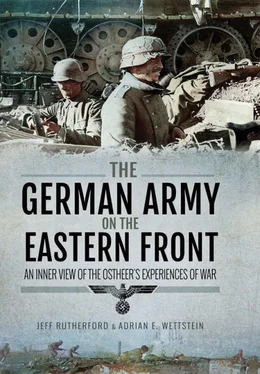Anti-Bolshevism and the desire to protect Germany from the imposition of such a regime clearly motivated large chunks of the German eastern army, as did the behaviours and actions of Red Army soldiers and NKVD troops, which only served to legitimize German propaganda. [19]
The German army’s string of unbroken victories that conquered continental Europe was finally broken in December 1941 when its last gasp offensive towards Moscow sputtered to a halt. The subsequent Soviet counterattack led to an existential crisis within its ranks, as the exhausted, frost-bitten and severely under-strength army was driven back hundreds of kilometres by the suddenly resurgent Red Army. [20]For the seemingly invincible German army, its first strategic retreat weighed heavily on the troops’ morale. The intelligence officer of the hard-pressed 7th Infantry Division distributed the following document to his men some two weeks after the opening of the Soviet counterattack. [21]
The Enemy Situation
The Red Army has now suffered the heaviest defeats in the past six months. It has been decisively weakened in men and material. Russia may have been barely successful in the last hour in constructing a front and holding Moscow, but the losses in territory and industrial areas, in valuable war material and trained troops are too great to decisively change the situation in the coming year. Thus the desperate break-out attempts from the Petersburg fortress matter as little as the continual attacks on single sections of the front, in that while leading to the winning of unimportant terrain, are not capable of influencing the entire situation. The Red Army has suffered defeat after defeat. If it has been successful in recent weeks in forcing back our troops, worn out from months of fighting and in need of rest from a few positions, this has no importance for the larger situation. Large sections of the front have remained spared from attacks and have been able to prepare for the defensive in quiet. The imminent snow period will also shortly lead to a slackening of the Russian attacks on the present relatively unsettled positions.
The German front in the East cannot be shattered.
It is absurd to judge the entire situation of the Eastern Front only from the combat strength of one unit. Not all divisions have been employed in so many focal points, as, for example, our 7th Division. Mogilev, the Roslavl highway, Yel’nya, Vereya, the Moscow highway were points of emphasis. Not all divisions have stood at such decisive spots, many still possess great fighting power. After the long period of quiet that the winter will bring, all will be ready for the decisive battle.
The Russians’ calls for help for the support from the side of England and America are no signs of strength. They obviously show that without help from abroad, the Red Army can no longer be brought to full combat strength by its own available military industry. However, now English help is very questionable, [and] American [assistance] has been completely eliminated by the war with Japan. Besides, developments in the Far East may force the Russians to keep the mass of their Siberian troops there.
The situation of the German East front [19]14/17 was occasionally more difficult than now and yet all crises were overcome, crises of completely different dimensions than those that have temporarily occurred on only a few sections of the front. The winter on the Carpathian Front [22]was much more onerous than that of the plains of central Russia. The opponent was never so smashed as today. Even in 1916, two years after the beginning of the war, he could overrun entire fronts and appear before the gates of Hungary in the Brusilov offensive. At the same time, strong German forces were committed in France, and more soldiers bled to death in the battles of Verdun and the Somme than in the entire campaign to date altogether.
One often hears the claim that the Russian of today is different than that of 1914. This is true and false. The majority of the Russians from then was perhaps more uniformly oriented than today when the entire peasantry stands in opposition to the Red Terror. But, then and now, the methods were the same. Then, it was the machine gun that drove the brown columns to attack, today are added the commissars, whose power will finally be broken in the year 1942 with the coming final account with communism.
This war is about the ‘to be or not to be’ of the Red rulers in the Kremlin. This explains the severity of the fighting. Any other government would have looked for an armistice after the great battles of annihilation during the fall of 1941. In this struggle, there is no armistice, there is only victory or defeat.
The task of the German Eastern Army is to force a German victory with all means and under all circumstances.
In this struggle, Japan has now also entered with completely fantastic initial successes. Japan is also fighting a war of life and death. The soldierly attitude of the Japanese Volk guarantees that this war will be carried out unerringly and ruthlessly. The Japanese Army in the Far East ties up strong Russian forces and stops any type of American supply through the Vladivostok harbour. So, the Japanese-American war constitutes a direct relief to our Eastern Front.
In the coming final battle, the remainder of Bolshevik Russia alone stands facing the German Army. And this army will triumph, because it wants to and must win!
This document proves instructive on several levels. First, the present crisis facing the German army was put into the larger context of Operation Barbarossa. Correctly arguing that the Red Army had suffered much heavier casualties during the course of 1941 than the Germans, the author tried to convince the men that the Soviet army was in worse shape than the German army, a view that was shared by much of the German High Command. Second, by comparing the present struggle to that of the First World War and by specifically mentioning touchstone battles from that conflict such as the Carpathian campaign, the Brusilov offensive, and twin battles of material, Verdun and the Somme, he was specifically playing upon their patriotism and devotion to their family members. By placing the winter crisis of 1941/42 into the larger continuum of defending Germany from its enemies during the twentieth century, he portrayed members of the 7th Infantry Division as heirs to the men who fought in the hellacious battles of the First World War, ones which were well-known to German soldiers fighting in its successor. The fact that many of the men now deep in the Russian heartland were sons and nephews of those who suffered and died at Verdun or in the Carpathians only increased the stakes; in order to reach the near-mythical status of their predecessors in field grey, these men had to do their duty, no matter the cost. Third, the missive argued that the Germany was not alone in the struggle to remake the world. The addition of Imperial Japan and its Volk firmly tipped the balance in favour of the Reich, because Japanese intervention in Asia and the Pacific would tie up British and American resources, leaving the Soviet Union alone in its struggle with Germany. The final point that emerges from the document concerns the importance of will. Both the Soviets and the Japanese were fighting a war of ‘to be or not to be,’ or in other words, ‘a war of life and death.’ The stakes were clearly as high for the German Reich and they could only be achieved by the army and its men possessing the necessary iron will to achieve its goals. The importance of this requisite will increasingly preoccupied the German High Command, as well as the Nazi political leadership. Even though the army and the National Socialist movement approached the notion of will from different perspectives, as the war continued to progress, both institutions looked to overcome Germany’s numerical inferiority through an utterly committed and even fanatical fighting force that shrank from nothing in its quest for final victory.
Читать дальше






![John Stieber - Against the Odds - Survival on the Russian Front 1944-1945 [2nd Edition]](/books/405234/john-stieber-against-the-odds-survival-on-the-russian-front-1944-1945-2nd-edition-thumb.webp)





